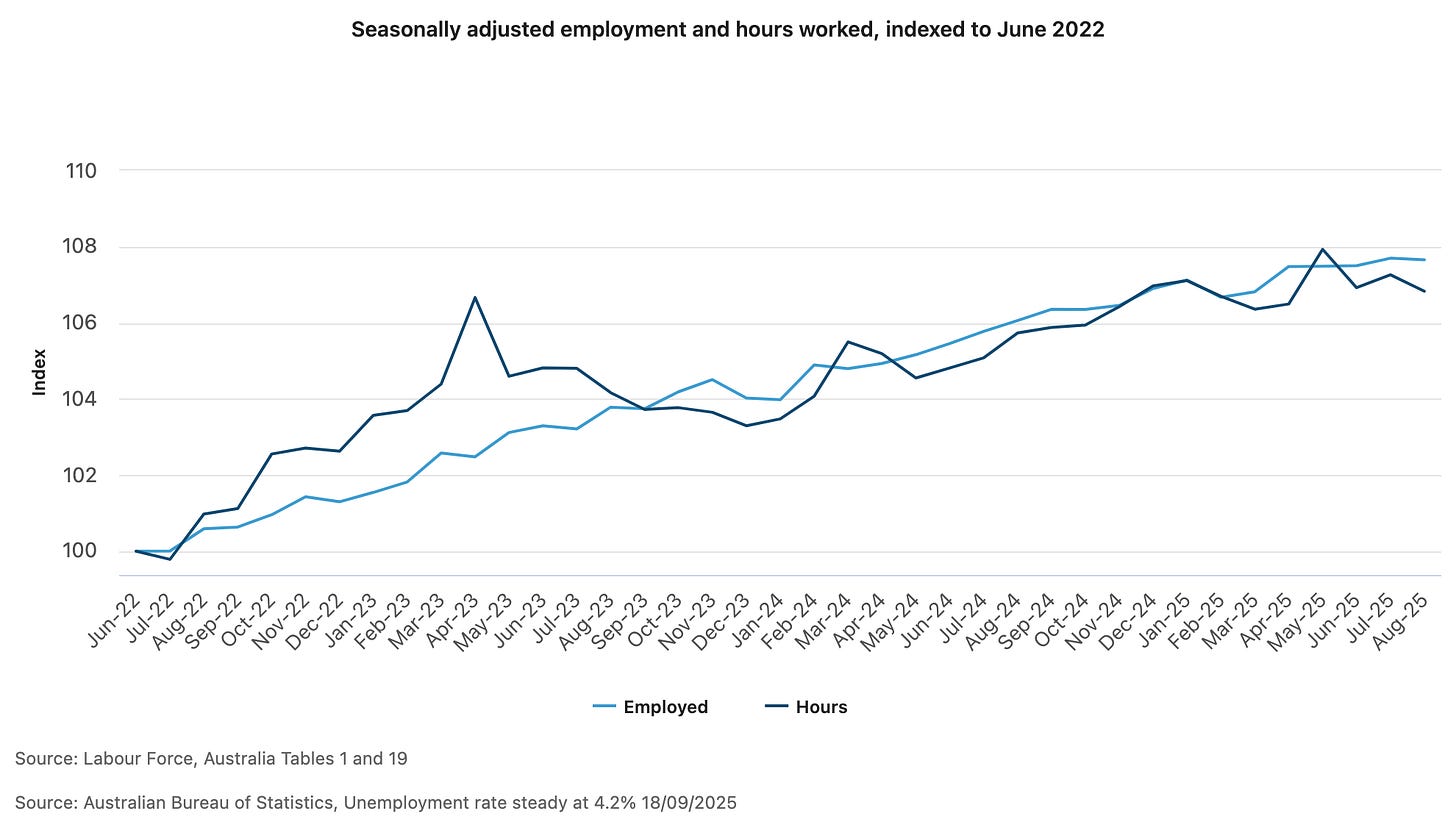Australia's Unemployment Rate Holds Steady at 4.2% Despite Employment Decline
Today’s Article is brought to you by Empower your podcasting vision with a suite of creative solutions at your fingertips.
This piece is freely available to read. Become a paid subscriber today and help keep Mencari News financially afloat so that we can continue to pay our writers for their insight and expertise.
Australia's unemployment rate remained unchanged at 4.2% in August despite a 5,000-person drop in employment, as fewer people actively sought work and part-time positions offset full-time job losses, according to data released today by the Australian Bureau of Statistics.
Sean Crick, ABS head of labour statistics, said employment and unemployment both declined simultaneously, keeping the jobless rate stable while the participation rate fell to 66.8%.
"Employment fell by 5,000 people and the number of unemployed fell by 1,000 people in August," Crick said. "This meant that the unemployment rate remained steady at 4.2 percent whilst the participation rate fell by 0.1 percentage points to 66.8 percent."
The employment-to-population ratio declined by 0.1 percentage points to 64.0%, reflecting the broader workforce participation changes during the month.
Truth matters. Quality journalism costs.
Your subscription to Mencari directly funds the investigative reporting our democracy needs. For less than a coffee per week, you enable our journalists to uncover stories that powerful interests would rather keep hidden. There is no corporate influence involved. No compromises. Just honest journalism when we need it most.
Not ready to be paid subscribe, but appreciate the newsletter ? Grab us a beer or snag the exclusive ad spot at the top of next week's newsletter.
Full-Time Jobs Drop as Part-Time Work Rises
A significant shift occurred between employment types, with full-time positions falling by 41,000 people while part-time employment rose by 36,000 people during August.
Women experienced the largest impact in full-time employment, losing 30,000 positions compared to 11,000 full-time job losses among men. However, both genders saw increases in part-time work, with female part-time employment rising by 18,000 and male part-time employment growing by 17,000.
"Hours worked fell 0.4 percent in August, supported by less people working full-time hours this month," Crick said, linking the decline in total work hours to the shift from full-time to part-time employment patterns.
Underemployment Continues Declining Trend
The underemployment rate, measuring workers seeking additional hours, fell by 0.1 percentage points to 5.7% in August. This represents a 0.8 percentage point improvement from August 2024 and a substantial 3.0 percentage point decline from March 2020 levels.
The underutilisation rate, combining unemployment and underemployment figures, also decreased by 0.1 percentage points to 9.9%. Year-over-year comparisons show the rate falling 0.7 percentage points from August 2024 and 4.0 percentage points below March 2020 figures.
These improvements suggest ongoing labor market recovery from pandemic-era disruptions, with fewer workers struggling to find adequate hours despite recent employment volatility.
Trend Data Shows Different Pattern
While seasonally adjusted unemployment remained flat, underlying trend data revealed a different trajectory, with the trend unemployment rate rising to 4.3% in August.
Trend employment grew by approximately 18,000 people, or 0.1%, during the month, with annual growth reaching 1.7% over the past 12 months.
Monthly hours worked increased by 0.1% in trend terms, matching similar growth in employment numbers. Both hours worked and employment showed identical annual growth rates of 1.7%.
"In trend terms, the participation rate remained at 66.9 percent in August, while the employment-to-population ratio stayed at 64.1 percent," Crick said, indicating more stability when seasonal factors are removed from the calculations.
Labor Market Resilience Amid Economic Uncertainty
The stable unemployment rate occurs against a backdrop of global economic volatility and domestic policy changes. The data covers the period from August 3 to August 16, 2025, capturing labor market conditions during a month of continued economic adjustment.
Employment growth over the past year demonstrates ongoing job creation despite monthly fluctuations. The 1.7% annual employment growth rate suggests sustained labor demand across various sectors of the Australian economy.
Part-time employment gains partially offsetting full-time losses may reflect changing employer preferences for flexible staffing arrangements or worker desires for improved work-life balance.
Methodology and Coverage
The ABS defines the labor force population as resident civilians aged 15 years and older when calculating employment statistics. The August survey reference period ran from August 3 through August 16, 2025.
Numbers in the release may not be additive due to statistical rounding practices. The ABS noted that more detailed information, including regional labor market data, will be available in the upcoming August 2025 issue of Labour Force, Australia, Detailed, scheduled for release on Thursday, September 25, 2025.
Ongoing Data Collection
The September survey reference period runs from August 31 through September 13, 2025, with results expected in the following monthly release cycle.
The ABS acknowledged continued cooperation from survey respondents, thanking Australians for their support in providing accurate labor market information during uncertain economic times.
Statistical Context
The trend underemployment rate remained steady at 5.8% while the trend underutilisation rate fell marginally to 10.0%, showing underlying improvement in labor market conditions beyond monthly volatility.
These figures contribute to broader economic indicators as policymakers assess labor market health amid global economic pressures and domestic policy adjustments.
The data release provides crucial information for economic planning and policy decisions as Australia navigates changing employment patterns and workforce participation trends.
Monthly labor force statistics serve as key indicators for understanding economic conditions and informing government and business decision-making regarding employment policies and workforce planning strategies.
Sustaining Mencari Requires Your Support
Independent journalism costs money. Help us continue delivering in-depth investigations and unfiltered commentary on the world's real stories. Your financial contribution enables thorough investigative work and thoughtful analysis, all supported by a dedicated community committed to accuracy and transparency.
Subscribe today to unlock our full archive of investigative reporting and fearless analysis. Subscribing to independent media outlets represents more than just information consumption—it embodies a commitment to factual reporting.
As well as knowing you’re keeping Mencari (Australia) alive, you’ll also get:
Get breaking news AS IT HAPPENS - Gain instant access to our real-time coverage and analysis when major stories break, keeping you ahead of the curve
Unlock our COMPLETE content library - Enjoy unlimited access to every newsletter, podcast episode, and exclusive archive—all seamlessly available in your favorite podcast apps.
Join the conversation that matters - Be part of our vibrant community with full commenting privileges on all content, directly supporting The Evening Post (Australia)
Catch up on some of Mencari’s recent stories:
It only takes a minute to help us investigate fearlessly and expose lies and wrongdoing to hold power accountable. Thanks!







